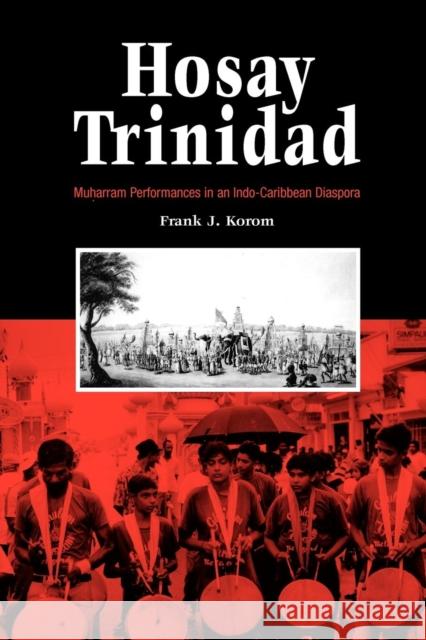Hosay Trinidad: Muharram Performances in an Indo--Caribbean Diaspora » książka
Hosay Trinidad: Muharram Performances in an Indo--Caribbean Diaspora
ISBN-13: 9780812218251 / Angielski / Miękka / 2002 / 320 str.
Hosay Trinidad: Muharram Performances in an Indo--Caribbean Diaspora
ISBN-13: 9780812218251 / Angielski / Miękka / 2002 / 320 str.
(netto: 129,76 VAT: 5%)
Najniższa cena z 30 dni: 130,31
ok. 30 dni roboczych
Bez gwarancji dostawy przed świętami
Darmowa dostawa!
Hosay Trinidad Muharram Performances in an Indo-Caribbean Diaspora Frank J. Korom "Hosay Trinidad should be considered a great publishing achievement. It is a livre de chevet, a must for scholars of Caribbean studies, anthropology, and the performing arts."--History of Religions "Hosay Trinidad contributes substantially to the anthropology of contemporary identity politics as well as to the study of 'boundaries' which has come to play a key role in important new lines of scholarship across the social sciences."--Anthropos "The book is free of jargon and recommended for anyone with an interest in contemporary interreligious issues, the possibilities within local Islamic cultures . . ., and questions of identity formation in a multicultural and multireligious society."--Religious Studies Review The multivocalic rite known as Hosay in the Caribbean developed out of earlier practices originating in Iraq and Iran which diffused to Trinidad by way of South Asian indentured laborers brought to the Caribbean by the British from the mid-1800s to the early decades of the twentieth century. The rituals are important as a Shi'i religious observance, but they also are emblems of ethnic and national identity for Indo-Trinidadians. Frank Korom investigates the essential role of Hosay in the performance of multiple identities by historically and ethnographically situating the event in Middle Eastern, South Asian, and Caribbean contexts. Hosay Trinidad: Muharram Performances in an Indo-Caribbean Diaspora is the first detailed historical and ethnographic study of Islamic muharram rituals performed on the island of Trinidad. Korom's central argument is that the annual rite is a polyphonic discourse that is best understood by employing multiple levels of interpretation. On the symbolic level the observance provides esoteric meaning to a small community of Indo-Trinidadian Muslims. On another level, it is perceived to be representative of "transplanted" Indian culture as a whole. Finally, the rituals are becoming emblematic of Trinidad's polyethnic population. Addressing strategies used to resist integration and assimilation, Hosay Trinidad is engaged with theories concerning the notion of cultural creolization in the Caribbean as well as in the general study of global diasporas. Frank J. Korom teaches religion and anthropology at Boston University. He is coeditor of Gender, Genre, and Power in South Asian Expressive Traditions, also available from the University of Pennsylvania Press. 2002 320 pages 6 1/8 x 9 1/4 31 illus. ISBN 978-0-8122-3683-5 Cloth $79.95s 52.00 ISBN 978-0-8122-1825-1 Paper $28.95s 19.00 World Rights Anthropology Short copy: "Hosay Trinidad contributes substantially to the anthropology of contemporary identity politics as well as to the study of 'boundaries' which has come to play a key role in important new lines of scholarship across the social sciences."--Anthropos
Hosay TrinidadMuharram Performances in an Indo-Caribbean DiasporaFrank J. Korom"Hosay Trinidad should be considered a great publishing achievement. It is a livre de chevet, a must for scholars of Caribbean studies, anthropology, and the performing arts."--History of Religions"Hosay Trinidad contributes substantially to the anthropology of contemporary identity politics as well as to the study of 'boundaries' which has come to play a key role in important new lines of scholarship across the social sciences."--Anthropos"The book is free of jargon and recommended for anyone with an interest in contemporary interreligious issues, the possibilities within local Islamic cultures . . . , and questions of identity formation in a multicultural and multireligious society."--Religious Studies ReviewThe multivocalic rite known as Hosay in the Caribbean developed out of earlier practices originating in Iraq and Iran which diffused to Trinidad by way of South Asian indentured laborers brought to the Caribbean by the British from the mid-1800s to the early decades of the twentieth century. The rituals are important as a Shi'i religious observance, but they also are emblems of ethnic and national identity for Indo-Trinidadians. Frank Korom investigates the essential role of Hosay in the performance of multiple identities by historically and ethnographically situating the event in Middle Eastern, South Asian, and Caribbean contexts. Hosay Trinidad: Muharram Performances in an Indo-Caribbean Diaspora is the first detailed historical and ethnographic study of Islamic muharram rituals performed on the island of Trinidad.Korom's central argument is that the annual rite is a polyphonic discourse that is best understood by employing multiple levels of interpretation. On the symbolic level the observance provides esoteric meaning to a small community of Indo-Trinidadian Muslims. On another level, it is perceived to be representative of "transplanted" Indian culture as a whole. Finally, the rituals are becoming emblematic of Trinidad's polyethnic population. Addressing strategies used to resist integration and assimilation, Hosay Trinidad is engaged with theories concerning the notion of cultural creolization in the Caribbean as well as in the general study of global diasporas.Frank J. Korom teaches religion and anthropology at Boston University. He is coeditor of Gender, Genre, and Power in South Asian Expressive Traditions, also available from the University of Pennsylvania Press.2002 | 320 pages | 6 1/8 x 9 1/4 | 31 illus.ISBN 978-0-8122-3683-5 | Cloth | $79.95s | L52.00 ISBN 978-0-8122-1825-1 | Paper | $28.95s | L19.00 World Rights | AnthropologyShort copy:"Hosay Trinidad contributes substantially to the anthropology of contemporary identity politics as well as to the study of 'boundaries' which has come to play a key role in important new lines of scholarship across the social sciences."--Anthropos











